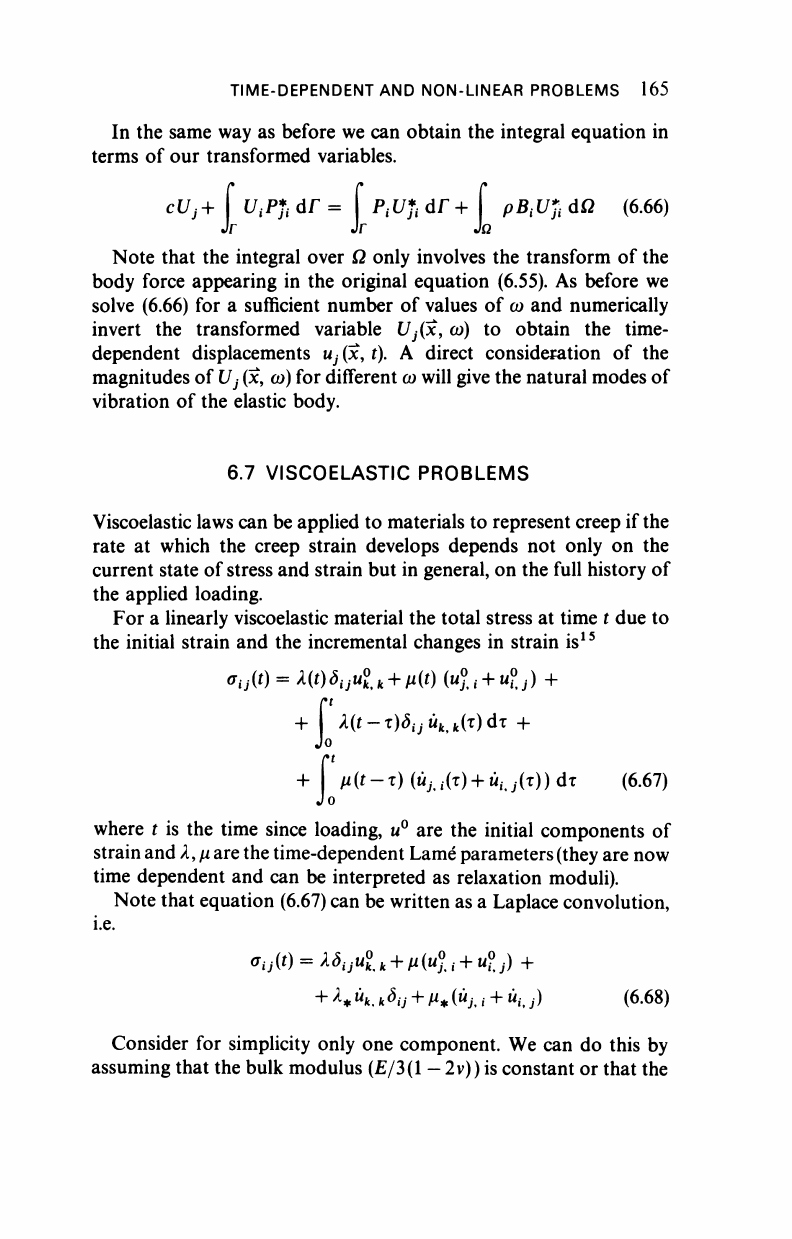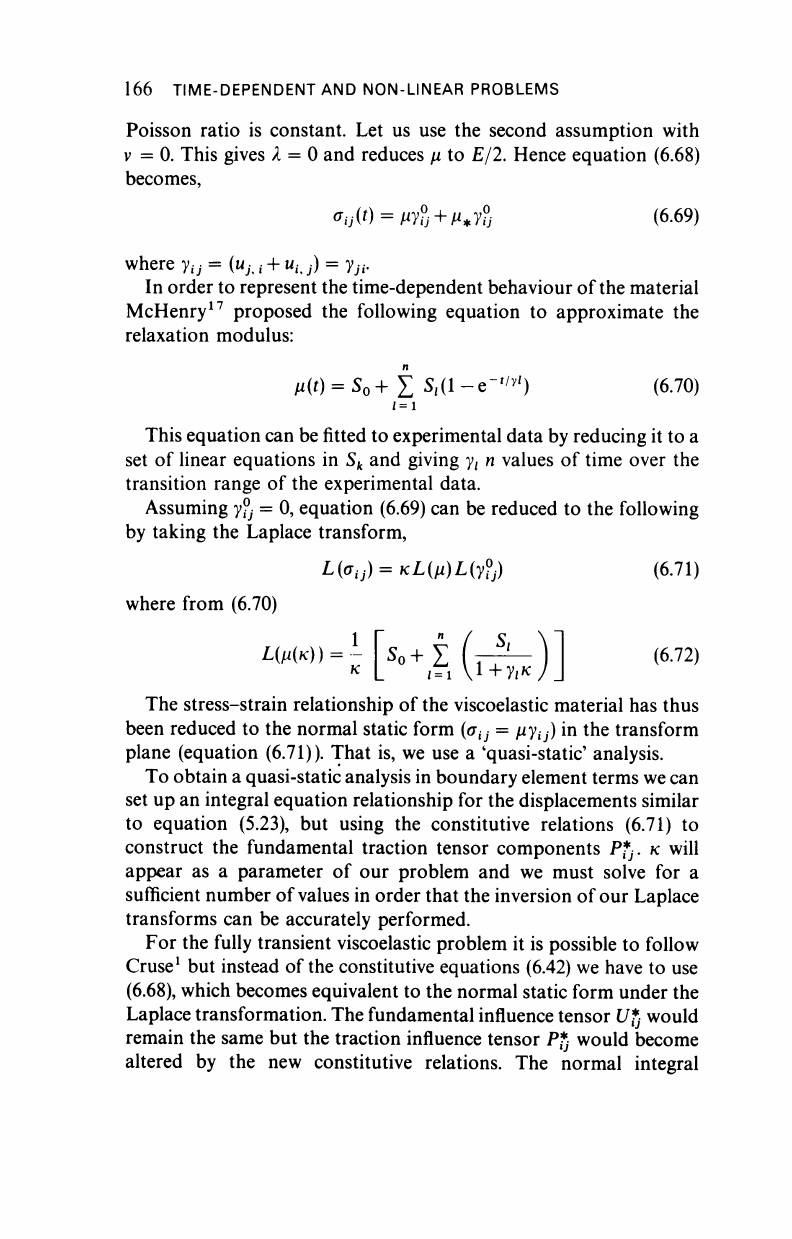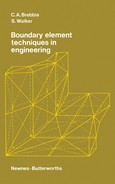
TIME-DEPENDENT AND NON-LINEAR PROBLEMS 165
In the same way as before we can obtain the integral equation in
terms of our transformed variables.
cUj+ f l/,PJi dr = [ PtUJt άΓ + f
pB
t
U%
άΩ (6.66)
Jr Jr JQ
Note that the integral over Ω only involves the transform of the
body force appearing in the original equation (6.55). As before we
solve (6.66) for a sufficient number of values of ω and numerically
invert the transformed variable Uj(x
9
ω) to obtain the time-
dependent displacements u, (x, t). A direct consideration of the
magnitudes of Uj (x, ω) for different ω will give the natural modes of
vibration of the elastic body.
6.7 VISCOELASTIC PROBLEMS
Viscoelastic laws can be applied to materials to represent creep if the
rate at which the creep strain develops depends not only on the
current state of stress and strain but in general, on the full history of
the applied loading.
For a linearly viscoelastic material the total stress at time t due to
the initial strain and the incremental changes in strain is
15
σ
υ
(ή =
λ(ήδ
υ
ηΙ
κ
+ μ(ί) (^ + ^) +
+ λ(ί-τ)δ^ύ
ΚΛ
{τ)άτ +
+ J μ(ί-τ) {ujjT) + u
itJ
(x))dx (6.67)
where t is the time since loading, u° are the initial components of
strain and λ, μ are the time-dependent Lame parameters (they are now
time dependent and can be interpreted as relaxation moduli).
Note that equation (6.67) can be written as a Laplace convolution,
i.e.
σ
υ
(ί) = ^Χ, +
μ(ιι?,
ι
+ ιι^) +
+ K K
k^ij
+ μ*
(ii;.
i
+
li,·,
j) (6.68)
Consider for simplicity only one component. We can do this by
assuming that the bulk modulus (£/3(l - 2v)) is constant or that the

166 TIME-DEPENDENT AND NON-LINEAR PROBLEMS
Poisson ratio is constant. Let us use the second assumption with
v = 0. This gives λ = 0 and reduces μ to E/2. Hence equation (6.68)
becomes,
*ij(t) = ß7v +
ß*7ü
(6.69)
where y
tj
= (u
h t
+ u
u}
) = y
jt
.
In order to represent the time-dependent behaviour of the material
McHenry
17
proposed the following equation to approximate the
relaxation modulus:
μ(ί) =
$
0
+Σ
S^l-e-"")
(6.70)
/ = i
This equation can be fitted to experimental data by reducing it to a
set of linear equations in S
k
and giving y
l
n values of time over the
transition range of the experimental data.
Assuming y° = 0, equation (6.69) can be reduced to the following
by taking the Laplace transform,
L(a
l}
) =
K
^)L(y%) (6.71)
where from (6.70)
LOi(ie)) = - s
0
+ X (-^— ) 1 (6.72)
The stress-strain relationship of the viscoelastic material has thus
been reduced to the normal static form (<r
i;
= μγ^) in the transform
plane (equation (6.71)). That is, we use a 'quasi-static' analysis.
To obtain a quasi-static analysis in boundary element terms we can
set up an integral equation relationship for the displacements similar
to equation (5.23), but using the constitutive relations (6.71) to
construct the fundamental traction tensor components Pfj. κ will
appear as a parameter of our problem and we must solve for a
sufficient number of values in order that the inversion of our Laplace
transforms can be accurately performed.
For the fully transient viscoelastic problem it is possible to follow
Cruse
1
but instead of the constitutive equations (6.42) we have to use
(6.68),
which becomes equivalent to the normal static form under the
Laplace transformation. The fundamental influence tensor U* would
remain the same but the traction influence tensor P£ would become
altered by the new constitutive relations. The normal integral
..................Content has been hidden....................
You can't read the all page of ebook, please click here login for view all page.
